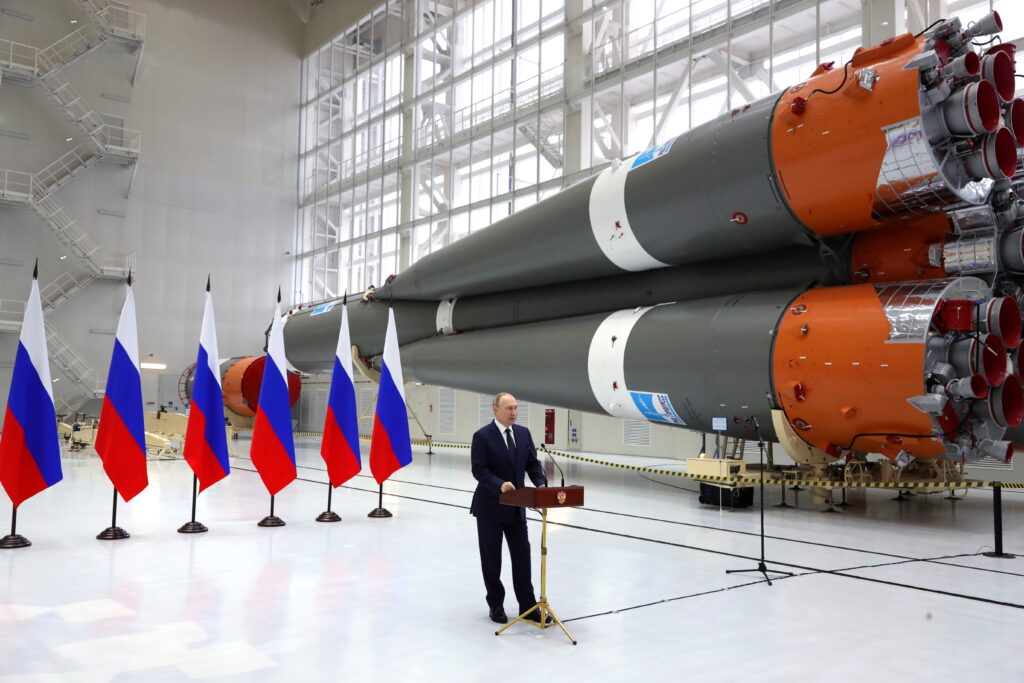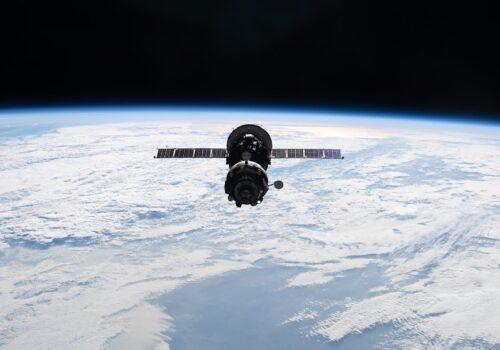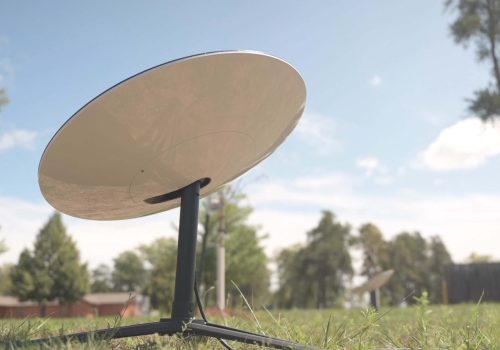The prospect of space combat is gripping Washington this week. The White House on Thursday confirmed that Russia is developing a “troubling” anti-satellite capability, following statements from leading members of Congress and ensuing reports that Russia is working on a nuclear-armed, on-orbit, anti-satellite weapon. The news has sparked concern about the imminence and degree of such a threat. If fielded, Russian nuclear-armed anti-satellite weapons, or ASATs, would directly challenge norms of responsible behavior in space and present a serious risk to all nations’ satellites. With or without such a system, nuclear and space threats from Russia call for a firm response by the United States and its allies and partners.
So what’s all the fuss about ASATs anyway?
Anti-satellite weapons have existed almost as long as satellites have. They are used to destroy or incapacitate satellites, either through physical destruction (crashing into a satellite with a missile or another satellite) or through non-kinetic attacks, such as by electromagnetic jamming, lasers, and cyberattacks.
Satellites orbiting in space are essential to everyday functions of life on Earth. Data that transits through satellites support the positioning, navigation, timing, and communications that modern society relies on—from financial transactions to Global Positioning System (GPS) navigation. Beyond these civilian uses, space systems support secure military and government communications, such as intelligence, command and control, missile warning, and more.
It follows that an adversary wishing to cause major disruption may seek to target satellites. While destructive ASATs have not yet been deployed in warfare, countries such as Russia, India, China, and the United States have demonstrated their ability to operate such weapons by destroying their own satellites. As countries’ reliance on space increases, the ability to hold other countries’ satellites at risk is a significant and concerning capability. Additionally, ASAT testing has generated significant orbital debris, which is a problem for the wider international community of spacefaring nations.
What is known about existing Russian ASATs
Today, Russia fields a range of ASAT capabilities, ranging from cyberattacks and the jamming of satellite signals to ground-based, direct-ascent, hit-to-kill ASAT missiles. In recent years, US officials and open-source researchers have raised concerns about large Russian satellites releasing smaller “daughter” satellites in space that are capable of approaching, interfering with, and potentially destroying US satellites.
To address these counterspace threats, the United States has sought to increase the resilience of its space systems, while doubling down on international norms against nuclear weapons in space and destructive ASAT testing. If put into operation, Russia’s possible nuclear ASAT would pose a test to these US efforts and international norms.
Nuclear-armed ASATs would cause mass destruction
The United States is moving away from a small number of large, expensive, complex satellites to constellations of smaller, cheaper satellites more resilient to kinetic attack. But the threat of nuclear attacks on satellites may change this calculus. In 2017, Gen. John Hyten, the then head of US Strategic Command, memorably stated that he would no longer “support buying big satellites that make juicy targets.” In part through the Space Development Agency, the US Space Force has moved toward an architecture that relies more on constellations of small satellites.
A kinetic attack from Earth on any single small satellite would be highly inefficient. But a nuclear attack presents a wider problem. A nuclear detonation in space would add significant radiation to orbits used by a number of US military satellites, causing them to degrade in the weeks and months following the detonation unless they are specifically hardened against radiation. A so-called high-altitude nuclear detonation against low-Earth orbit satellites (HALEOS) would also damage thousands of civilian satellites from all nations, making this a true weapon of mass destruction.
Moscow has a history of fielding nuclear-powered satellites that are not nuclear armed; and Russia is currently reinvigorating its nuclear-powered satellite program. Nuclear-powered satellites can generate additional energy to power electromagnetic jammers, radars, and other technologies that could be used for anti-satellite purposes. Nuclear power in space can also be used for spacecraft propulsion, which would allow a space asset to change orbits more frequently than a satellite powered with conventional propulsion. Still, a nuclear-powered Russian satellite is potentially less alarming than a nuclear-armed satellite, since it would neither be norm-shattering nor give Russia the ability to degrade a large swath of all satellites on orbit in one fell swoop.
A nuclear-armed ASAT would violate the Outer Space Treaty
The United States has long endorsed the principle of nonplacement of weapons of mass destruction in space, and more recently it has rallied support against destructive direct-ascent ASAT testing in space. The key piece of international law here is the 1967 Outer Space Treaty, which, among other provisions, prohibits the placement of weapons of mass destruction in outer space, which would be highly destabilizing.
A Russian nuclear-armed anti-satellite weapon stationed on orbit would be a flagrant violation of this principle. More recently, the Biden administration has committed the United States to refrain from destructive tests of direct-ascent ASATs and convinced several likeminded nations to make similar pledges. The goal of this moratorium on destructive ASAT testing is to increase predictability in space and reduce the generation of dangerous space debris.
Russia’s recent experiments with “exotic” nuclear weapons
Because Russia can already detonate nuclear weapons in space from Earth, a new nuclear-armed ASAT likely would not give Moscow significant new military capability, even though it remains concerning.
While a nuclear-armed ASAT would advance Russian counterspace capabilities, challenge US space strategy, undermine norms, and alarm allies, it does not appear to add a qualitatively different capability to the Russian arsenal. Any nation with a nuclear-armed intercontinental ballistic missile (ICBM) can detonate a nuclear weapon in space. Both the United States and the Soviet Union tested nuclear weapons in space during the Cold War.
In recent years, Russia has announced the development of several new so-called “exotic” nuclear weapons—including a nuclear-powered, nuclear-armed cruise missile and submarine drone—which Western analysts have found challenging to understand. These new weapons do not add a significant military capability to Russia’s nuclear arsenal, which is capable of inflicting unacceptable damage to the US homeland under virtually any circumstance. While there are plausible ways in which a nuclear-armed ASAT could be more effective than an ICBM-delivered nuclear detonation in space, such a development may be similar in practical effect to the rest of this class of exotic nuclear weapons.
A major concern, in addition to the potential weapon itself, is that this development would be grim news for the future of arms control and could potentially set in motion an arms race in space. If Russia were to abandon the Outer Space Treaty to field such a weapon (or to deploy it without withdrawing, in an echo of its treatment of the Intermediate-range Nuclear Forces Treaty, Open Skies Treaty, and New START), the act would further signal the end of the era of legally binding arms-limiting treaties between the United States and Russia.
A response is in order; hysteria is not
Hysteria is not in order. While concerning for international norms, signaling, and precedent, even if fielded, a nuclear ASAT capability would not significantly revise the US-Russia balance of power in space or on Earth. Still, the United States and its allies and partners must respond.
This development should serve as further impetus for US space planners to take seriously the prospect of nuclear use in space. Nuclear scholars are highly focused on the prospect of limited coercive nuclear use by US adversaries early in a major-power war, for example. Space planners should appreciate this risk and ensure that defense plans for high-end conflicts are resilient against a loss of unhardened space systems, either by hardening a sufficient number of systems or ensuring alternate sensing and communications options are in place. Further, if space norms are to mean anything, then the United States must rally like-minded nations to register their concern over this potential flagrant violation of the Outer Space Treaty.
Clementine Starling is the director of the Atlantic Council’s Forward Defense program.
Mark J. Massa is the deputy director for strategic forces policy at the Atlantic Council’s Forward Defense program, which hosts the Nuclear Strategy Project.
Further reading
Thu, Feb 15, 2024
Experts react: What to know about Russia’s apparent plans for a space-based nuclear weapon
Experts react By
Reports that Russia is developing a space-based nuclear anti-satellite weapon have raised national security concerns in Washington.
Thu, Jan 12, 2023
How the US and its allies should respond to evolving space threats
New Atlanticist By
Adversaries are changing the ways they disrupt or destroy US and allied space operations. Our experts give their sense of the latest challenges to security.
Tue, Aug 30, 2022
Early lessons from the Russia-Ukraine war as a space conflict
Airpower after Ukraine By
The Russia-Ukraine war may be remembered as the first two-sided space war, offering four preliminary lessons for future conflicts.
Image: Russian President Vladimir Putin delivers a speech as he visits the Vostochny Cosmodrome in Amur Region, Russia April 12, 2022. Sputnik/Mikhail Klimentyev/Kremlin via REUTERS ATTENTION EDITORS - THIS IMAGE WAS PROVIDED BY A THIRD PARTY.



